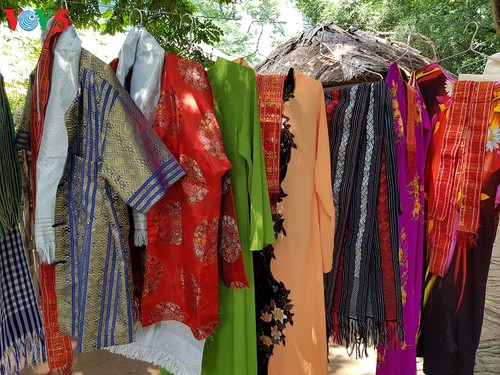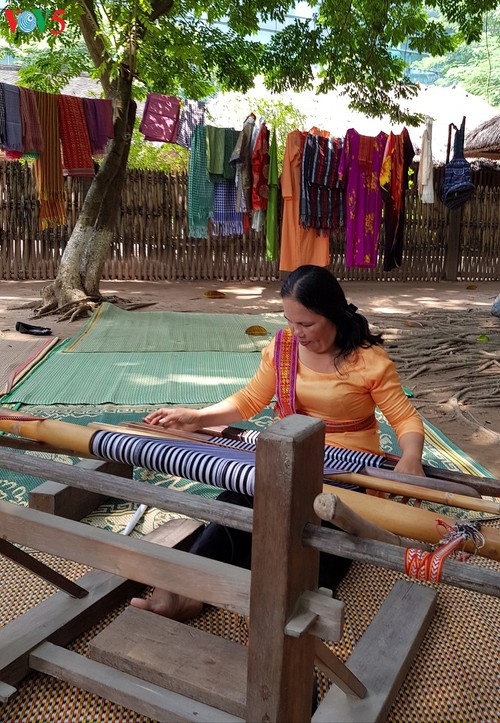 My Nghiep brocade village products (Photo: Ngoc Anh/VOV5) My Nghiep brocade village products (Photo: Ngoc Anh/VOV5) |
Legend has it that in Champa Kingdom in the 17th century, a lady named Po Nagar came to the area and taught weaving for a couple who lived in Cha Leng, now My Nghiep village. The villagers learned the craft and spread it widely.
According to village artisans, many stages are required to weave a piece of brocade cloth ranging from pitting for cotton fibers to rolling, soaking, drying, dyeing, and starching. Every stage needs the workers’ meticulous attention. To create the delicate and unique patterns, the weavers must possess an acute aesthetic sense and experience in mixing colors.

Artisan Ham Thi Nhu Y demonstrates brocade weaving at the Museum of Ethnology in Hanoi.
(Photo: Ngoc Anh/VOV5)
|
Ham Thi Nhu Y, an artisan of My Nghiep village, said: “Materials for weaving are silk or yarn depending on the demand or purpose of the person who wants to wear or order it. Popular products include long dresses, clothes, blankets, scarves, bed covers, and tablecloths. We have also created new products like backpacks, bags, and purses. There are two types of looms: long and short frame depending on fabric types.”
My Nghiep traditional brocade products are attractive thanks to the diversity of patterns, designs, motifs, and colors epitomized by the Cham culture.
In addition to ancient patterns like the god Shiva, the bird-like god Garuda, and dragons, My Nghiep villagers have created new designs like elephants of the Central Highlanders, the apricot of the Kinh people, and combined new materials such as synthetic fiber or glitter fabric.
Ho Si Son, Deputy Director of the Ninh Thuan provincial Culture, Sports, and Tourism Department, said: “The village’s products are made manually and are distinguishable from the items of other villages. Provincial authorities have disseminated a preservation plan under which training of weaving techniques will be maintained and product advertisement will be supported to attract tourists. Although we haven’t exported many products, they have been sold in many provinces and cities nationwide."
In other villages only old women engage in the craft whereas young people both girls and boys in My Nghiep practice the craft. Girls are in charge of handling the fibers and weaving fabrics and boys do designing and tailoring. Festivals are regularly also often organized at the village to introduce Cham brocade products to visitors near and far. Local artisan Ham Thi Nhu Y said: “Our products have been available in the domestic market and exported to India, Thailand, and the US. The village now has 300 households engaged in weaving. Several generations of my family have followed the occupation. A brocade craft village cooperative has been established. Each household is in charge of a production stage thus the work has become more effective. Natural silk turns out better and more durable products.”
The Cham people mainly live in Vietnam’s south central region. A majority are in Ninh Thuan province. Brocade weaving has long been a cultural symbol of the Cham ethnic group and their brocade products are favored nationwide.